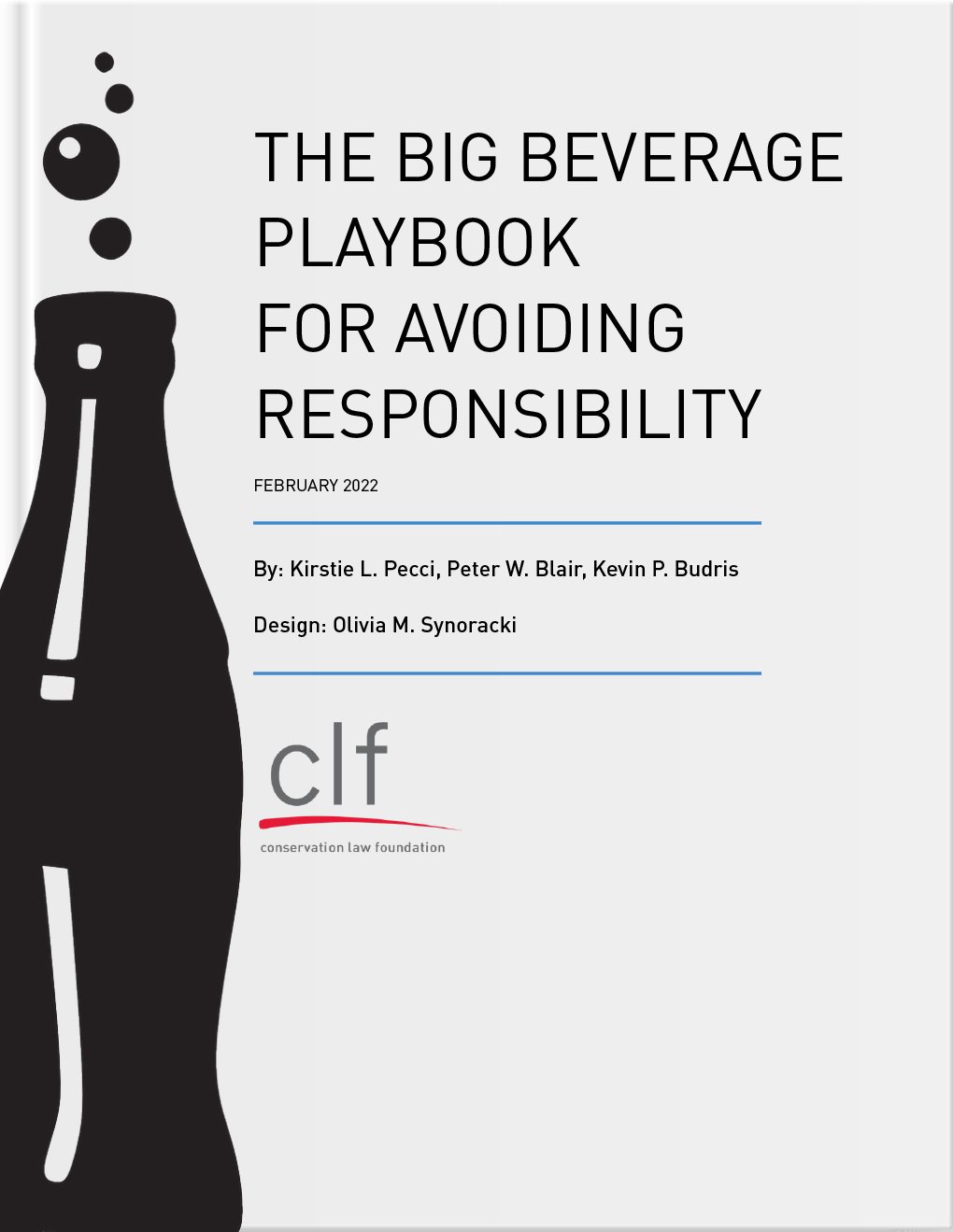The Big Beverage Playbook For Avoiding Responsibility
February 2022 | Conservation Law Foundation (CLF)
Big Beverage companies, including Coca-Cola, PepsiCo, and Nestlé, are driving the global plastic pollution crisis. This is due, in large part, to the single-use plastic containers in which they sell their beverages. While all beverage container sales in the United States have skyrocketed in recent years, single-use plastic bottles have become particularly popular among the beverage industry.
Why? Because virgin plastic is dirt cheap compared to glass and aluminum. And, because corporations are not responsible for the costly impacts pollution has on our communities and environment.
Although it’s well known that virgin plastic production is a major contributor to climate change, Big Beverage often distracts us from this reality. The industry does so by running marketing campaigns that target recycling as the solution.
The problem is that our curbside recycling system is failing us. And that’s because it wasn’t designed to manage all our recyclables. Many of us try to do our part by placing empty bottles and cans in our recycling bins, but most of those containers inevitably end up in landfills and incinerators. Too many containers also end up as litter in our streets and waterways. Photos of plastic-filled oceans and strangled wildlife show only the most visible impacts of this pollution. Sadly, the generation and disposal of these plastic bottles also creates significant environmental and public health risks.
But there is good news. We have a system that can effectively collect, process, and recycle all these containers. Deposit return systems, more commonly known as “Bottle Bills,” place a fee on bottles and cans that consumers get back when they return the containers. These programs are free to taxpayers, because the producers pay for any handling fees required to fund the system. Bottle Bills are a highly effective mechanism for collecting and recycling large volumes of empty beverage containers. In fact, since the 1970s, these programs have proven to be the most effective post-consumer recycling systems ever created.
Despite the success of Bottle Bills, Big Beverage has spent years sabotaging attempts to improve recycling through new or expanded Bottle Bills so they can avoid paying handling fees. How? By using a well-known playbook designed to delay, distract, and derail recycling reform using five key tactics:
Blame the consumer
Lobby to defeat Bottle Bills
Silence support for systemic change
Makes promises, then break them
Play along, then undermine
Understanding Big Beverage’s playbook helps consumers and lawmakers break free from the status quo and modernize or pass new Bottle Bills, despite corporate opposition. But we’ve determined that, for Bottle Bills to be truly effective, they must include six characteristics:
Standards in the law. Only state lawmakers and regulators – not the beverage industry – should have ultimate authority to design the deposit system. This includes aspects like the redemption network, the deposit value, and performance targets. Transparency measures and penalties for failing to reach performance targets must also be set in the law, and enforcement must be automatic and immediate.
Explicit performance targets. The law must set aggressive performance targets for redemption, recycling, post-consumer recycled content, and refill and reuse that start small but ramp up within 10 years. Redemption and recycling targets should be set at 90% as soon as possible. These targets will ensure that the program is operating as effectively as possible while mandating the needed transition from single-use beverage containers to reusable and refillable containers.
Clear definitions. The law must have clear definitions of all key terms including what qualifies as recycling. The definition of recycling cannot allow for greenwashing and/or downcycling materials for less valuable uses. For instance, burning bottles and cans, or grinding up glass for use as landfill cover or roadbed, should never be included in the definition of “recycling.” These definitions must be set in statute, and the beverage industry cannot be allowed to water them down.
Broad list of beverage containers covered. The beverage containers covered by the program should include almost all aluminum, plastic, and glass bottles and cans of up to three liters. Aseptic packaging, cartons, and pouches should be included only if they can be recycled at rates that meet the recycling targets set in the legislation for bottles and cans.
Deposit value. The deposit should be set at a minimum of 10 cents per container. The law should include a trigger that automatically raises the value of the deposit if the collection rate drops below the predetermined level of 90%. Additionally, the deposit and handling fee should automatically increase over time to account for inflation so the deposit remains a large enough incentivize for customers to return their bottles and cans.
Universal return to retail. The law must allow customers to return beverage containers to any store that sells beverages. This consumer-friendly component makes redemption easier, more equitable for those who rely on public transit, more efficient, and cheaper.


